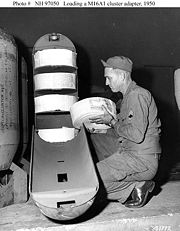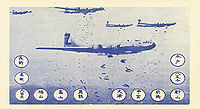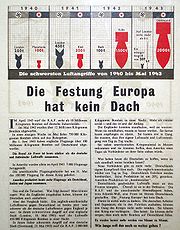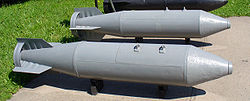
Airborne leaflet propaganda
Encyclopedia

Psychological warfare
Psychological warfare , or the basic aspects of modern psychological operations , have been known by many other names or terms, including Psy Ops, Political Warfare, “Hearts and Minds,” and Propaganda...
in which leaflets (flyer
Flyer (pamphlet)
__notoc__A flyer or flier, also called a circular, handbill or leaflet, is a form of paper advertisement intended for wide distribution and typically posted or distributed in public place....
s) are scattered in the air. Military forces have used aircraft
Aircraft
An aircraft is a vehicle that is able to fly by gaining support from the air, or, in general, the atmosphere of a planet. An aircraft counters the force of gravity by using either static lift or by using the dynamic lift of an airfoil, or in a few cases the downward thrust from jet engines.Although...
to drop leaflets to alter the behavior of people in enemy-controlled territory, sometimes in conjunction with air strikes. Humanitarian air missions, in cooperation with leaflet propaganda, can turn civilians against their leadership while preparing them for the arrival of enemy troops.
Functions of leaflet propaganda

- Threaten destruction
- Warn enemy troops and civilians that their area will be targeted.
- Prompt the enemy to surrenderSurrender (military)Surrender is when soldiers, nations or other combatants stop fighting and eventually become prisoners of war, either as individuals or when ordered to by their officers. A white flag is a common symbol of surrender, as is the gesture of raising one's hands empty and open above one's head.When the...
- Explain to prospective deserters how to surrender.
- Offer rewards
- Rewards could be offered to encourage individuals to provide assistance, or to encourage defection.
- Disseminate or counter disinformation
- Reduce enemy morale through propagandaPropagandaPropaganda is a form of communication that is aimed at influencing the attitude of a community toward some cause or position so as to benefit oneself or one's group....
. - Neutralize enemy propaganda.
- Advise radio listeners about frequencies/times of propaganda broadcasts and methods for circumventing radio jammingRadio jammingRadio jamming is the transmission of radio signals that disrupt communications by decreasing the signal to noise ratio. Unintentional jamming occurs when an operator transmits on a busy frequency without first checking whether it is in use, or without being able to hear stations using the frequency...
.
- Reduce enemy morale through propaganda
- Facilitate communication
- Create a friendly atmosphere for the enemy by promoting ideologies such as freedom, capitalismCapitalismCapitalism is an economic system that became dominant in the Western world following the demise of feudalism. There is no consensus on the precise definition nor on how the term should be used as a historical category...
, and "noble intentions".
- Create a friendly atmosphere for the enemy by promoting ideologies such as freedom, capitalism
- Provide humanitarian assistance
- Inform people where to find airdropped food, how to open and consume it, and why it comes.
Before World War II
Airborne leaflets have been used for military propaganda purposes at least since the 19th century. One early example is from the Franco-Prussian War when in October 1870 during the Siege of ParisSiege of Paris
The Siege of Paris, lasting from September 19, 1870 – January 28, 1871, and the consequent capture of the city by Prussian forces led to French defeat in the Franco-Prussian War and the establishment of the German Empire as well as the Paris Commune....
a French balloon coming from the city dropped government proclamations over Prussian troops that stated the following (in German):
"Paris defies the enemy. The whole of France rallies. Death to the invaders. Foolish people, shall we always throttle one another for the pleasure and proudness of Kings? Glory and conquest are crimes; defeat brings hate and desire for vengeance. Only one war is just and holy; that of independence."
Leaflet propaganda has been delivered by airplanes since the Italo-Turkish War
Italo-Turkish War
The Italo-Turkish or Turco-Italian War was fought between the Ottoman Empire and the Kingdom of Italy from September 29, 1911 to October 18, 1912.As a result of this conflict, Italy was awarded the Ottoman provinces of Tripolitania, Fezzan, and...
of 1911-12.
World War II
After World War I, Americans were skeptical due to the national consensus that America was pressured into WWI by false, manipulative propaganda laced with lies from both the British and the Germans. However, as J.A.C. Brown articulated, “propaganda is successful only when directed at those who are willing to listen, absorb the information, and if possible act on it, and this happens only when the other side is in a condition of lowered morale and is already losing the campaign”. Therefore, the use of airborne leaflets was a way for WWII enemies to psychologically attack one another in a different way than in previous wars. Distribution of Airborne leaflet propaganda was used by both allied and Axis forces in the Second World War.
Although leaflets were seen as being an effective tactic in manipulating troops when morale was low, “during the early months of the war, leaflets or pamphlets were scattered over enemy territory by aircraft and balloons but it was more than doubtful whether these had any useful effect, their obvious defects being that few can have reached their targets and, being printed, they were sometimes out of date by the time they were ready to distribute. The front-line distribution of leaflets was quite another matter and these were dropped by aircraft or fired by shells, the messages they bore being less careful about the general principles of consistency and frankness and only truthful about matters on which the enemy had contradictory information”. It was found that psychological warfare was not effective when distributing surrender leaflets to an enemy which currently had a high morale amongst its troops. Despite the pitfalls to airborne leaflets ineffectiveness on opposing sides with high morale, enemies used this tactic “to cause the men to begin talking to each other about their poor military position, their desire to stay alive for their families’ sakes, and the reasonableness of honorable surrender”, which often led men to desert their troops.
One example of German leaflets which appealed to American troops was one that depicted a passionate kiss between a man and woman. The leaflet read: “FAREWELL Remember her last kiss…? Gee were you happy then…! Together, you spent marvelous times…, lounging on beaches…, dancing, enjoying parties galore.., listening to the tunes of your favorite band…”. The leaflets back side reminds the soldier that his loved one is longing for him and that most of the men he had come with are now dead. This leaflet was the attempt of the Germans to pull at the heart strings of the American men in Europe. Reminding them of their loved ones, and that if they continue fighting, they may die and leave loved ones behind.
Comparatively, the allied troops were able to persuade the Axis forces by using no words at all in one of their airborne leaflets. This leaflet simply shows a picture of a large open field with thousands of graves of German soldiers. This leaflet, dropped over Germany in 1942, is the Allied forces direct way to tell the soldiers what their fate is by longing for an Iron Cross.
After World War II
Even though leaflet propaganda has been an effective “weapon”, its use has been on a decline. This decline is a result of the advance of satellite, television, and radio technology. Six billion leaflets were dropped in Western EuropeWestern Europe
Western Europe is a loose term for the collection of countries in the western most region of the European continents, though this definition is context-dependent and carries cultural and political connotations. One definition describes Western Europe as a geographic entity—the region lying in the...
alone during World War II
World War II
World War II, or the Second World War , was a global conflict lasting from 1939 to 1945, involving most of the world's nations—including all of the great powers—eventually forming two opposing military alliances: the Allies and the Axis...
. One billion were used during the Korean War
Korean War
The Korean War was a conventional war between South Korea, supported by the United Nations, and North Korea, supported by the People's Republic of China , with military material aid from the Soviet Union...
while only thirty one million have been used in the war against Iraq
Iraq
Iraq ; officially the Republic of Iraq is a country in Western Asia spanning most of the northwestern end of the Zagros mountain range, the eastern part of the Syrian Desert and the northern part of the Arabian Desert....
. Other conflicts where leaflet propaganda has been used are Vietnam
Vietnam
Vietnam – sometimes spelled Viet Nam , officially the Socialist Republic of Vietnam – is the easternmost country on the Indochina Peninsula in Southeast Asia. It is bordered by China to the north, Laos to the northwest, Cambodia to the southwest, and the South China Sea –...
, Afghanistan
Afghanistan
Afghanistan , officially the Islamic Republic of Afghanistan, is a landlocked country located in the centre of Asia, forming South Asia, Central Asia and the Middle East. With a population of about 29 million, it has an area of , making it the 42nd most populous and 41st largest nation in the world...
(both during the Soviet and more recent NATO invasions), and the Gulf War
Gulf War
The Persian Gulf War , commonly referred to as simply the Gulf War, was a war waged by a U.N.-authorized coalition force from 34 nations led by the United States, against Iraq in response to Iraq's invasion and annexation of Kuwait.The war is also known under other names, such as the First Gulf...
. Leaflets encouraging Iraqi troops not to fight were dropped during the first Gulf War which contributed to eighty thousand Iraqi troops surrendering in 1991.
Means of Delivery
Leaflet delivery can be as simple as having one or more of the aircraft's crew throwing bundles of leaflets out of an open hatchway. A more sophistocated method is the leaflet bomb. This is not an explosive device, but rather a bomb–shaped container that is dropped from the aircraft and opens in mid-air, dispersing the leaflets it holds, one may contain tens of thousands of leaflets.
Leaflet bombs in the US inventory include the PDU-5B dispenser unit
PDU-5B dispenser unit
The PDU-5/B is an aircraft-deployed leaflet dispenser unit. It is derived from the CBU-100 "Rockeye" Cluster Bomb, developed by the US Air Force circa 1999. It was used successfully in Afghanistan and Iraq to distribute leaflets.-External links:* * * *...
, the LBU30 and the older M129E1/E2. The M129 weighs 52 kilograms (115 lb) when empty and approximately 100 kilograms (220.5 lb) when loaded. It can contain 60,000 to 80,000 leaflets. At a pre–determined time after release, the two halves of the bomb's outer shell are blown apart by detonating cord
Detonating cord
Detonating cord is a thin, flexible plastic tube filled with PETN . With the PETN exploding at a rate of approximately 4 miles per second, any common length of det cord appears to explode instantaneously...
, dispersing the leaflet payload.
Soviet/Russian leaflet bombs include the AGITAB-250-85 and the AGITAB-500-300 (used during the First Chechen War
First Chechen War
The First Chechen War, also known as the War in Chechnya, was a conflict between the Russian Federation and the Chechen Republic of Ichkeria, fought from December 1994 to August 1996...
).
During World War 2, the British used hydrogen balloons to carry leaflets over German lines. Some of the V-1 flying bomb
V-1 flying bomb
The V-1 flying bomb, also known as the Buzz Bomb or Doodlebug, was an early pulse-jet-powered predecessor of the cruise missile....
s launched by the Germans against southern England carried leaflets - they were contained in a cardboard tube at the tail of missile. This would be ejected by a small gunpowder charge while the V1 was in mid-air, en-route to its target.
Use of leaflet bombs by revolutionary groups
Leaflet bombs have not only been used by states for purposes of military warfare but have since the 1940s also been used by radical political and ideological sub-state groups.Anti-colonial groups in Asia and Africa
The use of leaflet bombs by non-state groups began in 1945 when the IrgunIrgun
The Irgun , or Irgun Zevai Leumi to give it its full title , was a Zionist paramilitary group that operated in Mandate Palestine between 1931 and 1948. It was an offshoot of the earlier and larger Jewish paramilitary organization haHaganah...
group developed a bomb that was "deposited in the street, ticked away until detonation, then scattered news sheet over a wide and smoky area". In September 1945 three of Irgun's leaflet bombs exploded in Jerusalem and injured nine people.
In the late 1960s the African National Congress
African National Congress
The African National Congress is South Africa's governing Africanist political party, supported by its tripartite alliance with the Congress of South African Trade Unions and the South African Communist Party , since the establishment of non-racial democracy in April 1994. It defines itself as a...
(ANC) started to use a version of the leaflet bomb in South Africa. This bomb was developed in collaboration with the South African Communist Party (SACP) and South Africans living in exile in London. The first time this leaflet bomb, known to South African activists as the 'bucket bomb' and to the South African police forces as the 'ideological bomb', was used was in 1967. This was one of the most important propaganda weapons of the ANC as can be seen by the resources devoted to it and its frequent use during the 1960s and 1970s spreading tens of thousands of leaflets. ANC hailed it publicly as a central technology in their efforts as shown by this quote from ANC's journal Sechaba in 1970 looking back at the uses of leaflets as propaganda in the 1960s:
"It was in this new period that underground propaganda, demonstrating the effectiveness of the ANC machinery and projecting its voice, became of incalculable value. Underground leaflets began to appear in the townships, factories and city streets. Passed on from hand to hand, these reminded the people that the spirit of resistance must never die. These were often complemented by slogans painted on walls proclaiming: "Free Mandela," "Free Sisulu" and "Long Live the ANC." as modest as these propaganda efforts were [...] they showed that the ANC could survive the most severe measures of the regime." [Emphasis added]
Furthermore, the South African press and security forces also saw it as a very important weapon of the ANC as can be evidenced by the threats from the police to take action against the South African press for publishing parts of ANC's leaflets. The South African Minister of Police even acknowledged publicly that the importance of ANC's leaflet bombs when he was quoted in a South African newspaper stating that "the explosions are an indication that subversive elements are still active" inside South Africa and warned the "public" that they "must not think the dangers are a thing of the past. It is something with which we will just have to live." As this statement makes clear the South African police saw this as a weapon causing and indicating a terror among the public.
New left groups in Latin America
The leaflet bomb has been relatively popular in Latin America with several recorded uses by various groups advocating political violence.In the 1980s the FMLN in El Salvador used this technology under the name of 'propaganda bomb'. It was one of the "favorite tactics" of its urban militia groups and preferable used in public places like markets or public parks. The design of the bomb was adapted to the local environment in that it
"consisted of a cardboard box with a small, low-power explosive underneath a large number of propaganda leaflets. The explosive was set off by a homemade time igniter. The box was disguised to look like any ordinary package or box that might be carried by someone going or returning from a trip to the marketplace."
The use of leaflet bombs played a part in the FMLN's recruitment process known to them as fogueo - which meant to experience fire or fire-harden something - which was the process by which the recruits "were toughened and the weak and fainthearted were weeded out". The fogueo process was
"a very carefully designed program of increasingly risky operations in support of the guerilla movement. As the candidates successfully completed each operation, it gave them confidence to carry out the next danger level of operation until they became full-fledged guerilla combatants."
This process began with low-level information-gathering and propaganda activities in support of FMLN where the culminating activity before being ready for "combat military activity" could be the making and exploding of a leaflet bomb.
In Honduras the Popular Movement for Liberation (MPL) and Morazanist Patriotic Front
Morazanist Patriotic Front
The Morazanist Patriotic Front is a paramilitary group operating in Honduras. It has the aim of limiting United States involvement in Honduras, possibly with links to former Nicaraguan government officials. Although linked with the Communist Party of Honduras, it has not set out any Marxist aims...
(FPM) have also used propaganda bombs during the 1990s.
The Guatemalan National Revolutionary Unity URNG in Guatemala also used leaflet bombs. In 1996 the group occupied a radio station and set off a leaflet bomb.
In Ecuador several groups have used leaflet bombs. The Revolutionary Armed Corps (CAR) was according to the Ecuadorian police "an extreme leftist group" which is only known for one attempted attack on February 20, 2001 when a leaflet bomb containing 150 pamphlets was discovered and successfully defused by the police.
The communist Group of Popular Combatants (GCP) has on several occasions during 2001-2005 used leaflet bombs. In 2001 it was blamed by authorities for a pamphlet bomb and later the same year the group claimed responsibility for detonating a pamphlet bomb in downtown Quito that let out hundreds of pamphlets protesting against Plan Colombia. In 2002 The Revolutionary Armed Forces of Ecuador set off a leaflet bomb in a McDonald’s restaurant in Guayaquil that injured three people and caused severe damage to the property.
Advantages of leafleting
- The printed words on the leaflets were more authoritative before the advances in technology.
- One leaflet has the potential to reach many civilians.
- Leaflets can be hidden and easily destroyed in case of emergency.
Disadvantages
- Due to illiteracy not all civilians are capable of reading the leaflets.
- In order to have accurate delivery, aircraft need to fly at low altitudes and low speeds making them easy targets for the enemy.
- Leaflets can be destroyed or altered by the enemy.
- Messages must cater to the cultural norm of society.
- Weather conditions can alter the message being delivered to civilians.
See also
- Operation CornflakesOperation CornflakesOperation Cornflakes was a World War II Office of Strategic Services PSYOP mission in 1944 and 1945 which involved tricking the German postal service Deutsche Reichspost into inadvertently delivering anti-Nazi propaganda to German citizens through mail....
: A more subtle propaganda operation in World War II involving inserting propaganda leaflets by air into the mail system of Nazi Germany.
External links
- PsyWar.Org - The history of psychological warfare with a large collection of aerial propaganda leaflets
- WW2 propaganda - Allied and Axis leaflets: A website about airdropped, shelled or rocket fired propaganda leaflets in World War 2.
- DXing.info - leaflets in Iraq in 2003

